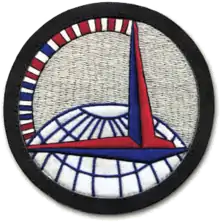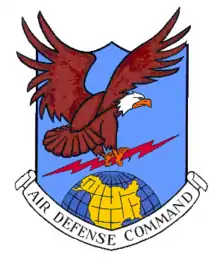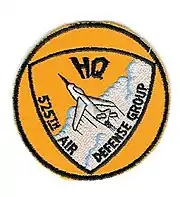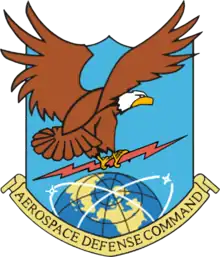525th Air Defense Group
The 525th Air Defense Group is a disbanded United States Air Force organization. Its last assignment was with the 4710th Air Defense Wing at New Castle County Airport, Delaware. It was inactivated on 18 August 1955. The group was originally activated as a support unit for a combat group at the end of World War II in Italy and then redeployed to Maine, where it supported redeploying units until it was inactivated in 1945.
525th Air Defense Group
  | |
|---|---|
 332d Fighter-Interceptor Squadron F-94C Starfire at Nellis AFB | |
| Active | 1945, 1953–1955 |
| Country | |
| Branch | |
| Type | Fighter Interceptor |
| Role | Air Defense |
| Part of | Air Defense Command |
| Insignia | |
| Patch showing the 525th Air Defense Group Emvlem |  |
The group was activated once again in 1953, when ADC established it as the headquarters for a dispersed fighter-interceptor squadron and the medical, maintenance, and administrative squadrons supporting it. It was replaced in 1955 when ADC transferred its mission, equipment, and personnel to the 82d Fighter Group in a project that replaced air defense groups commanding fighter squadrons with fighter groups with distinguished records during World War II.
History
World War II
The group was first activated in Italy as the 525th Air Service Group shortly before the end of World War II in a reorganization of Army Air Forces (AAF) support groups in which the AAF replaced Service Groups that included personnel from other branches of the Army and supported two combat groups with Air Service Groups including only Air Corps units. Designed to support a single combat group.[1] Its 951st Air Engineering Squadron provided maintenance that was beyond the capability of the combat group, its 775th Air Materiel Squadron handled all supply matters, and its Headquarters & Base Services Squadron provided other support.[1] It provided support to a combat group in Italy in 1945. The group redeployed to US and provided support to flying groups redeploying from Europe until it was inactivated. It was disbanded in 1948.[2]
Cold War
The group was reconstituted, redesignated as the 525th Air Defense Group, and activated during the Cold War at New Castle County Airport in 1953[3] with responsibility for air defense of Mid-Atlantic region of the United States. The group was assigned the 96th Fighter-Interceptor Squadron (FIS), which was already stationed at New Castle, and flying Lockheed F-94 Starfires[4] as its operational component.[5] The 96th FIS had been assigned directly to the 4710th Defense Wing.[5] The group also replaced 82nd Air Base Squadron as USAF host organization at New Castle County Airport. It was assigned three squadrons to perform its support responsibilities.[6][7]
One month after the group was activated, the 332d FIS, flying later model "Starfires" armed with Mighty Mouse Rockets rather than cannons,[8] was activated as the group's second operational squadron.[9] In July 1953 the 96th FIS upgraded to the newer model "Starfires" as well.[4] The 525th was inactivated[3] and replaced by the 82d Fighter Group (Air Defense)[10] as part of Air Defense Command's Project Arrow, which was designed to bring back on the active list the fighter units which had compiled memorable records in the two world wars.[11] The group was disbanded once again in 1984.[12]
Lineage
- Constituted as 525th Air Service Group
- Activated on 12 May 1945
- Inactivated on 15 October 1945
- Disbanded on 8 October 1948
- Reconstituted and redesignated as 525th Air Defense Group on 21 January 1953
- Activated on 16 February 1953
- Inactivated on 18 August 1955
- Disbanded on 27 September 1984
Assignments
- Unknown, 12 May 1945 – 1945 (probably Air Service Command, Mediterranean Theater of Operations)
- Atlantic Division, Air Transport Command, 1945 – 8 October 1945
- 4710th Defense Wing (later 4710th Air Defense Wing), 16 February 1953 – 18 August 1955
Components
|
Operational Squadrons
|
Support Units
|
Stations
- Italy, 12 May 1945 – 1945
- Presque Isle Army Airfield, Maine, 1945 – 15 October 1945
- New Castle County Airport, Delaware, 16 February 1953 – 18 August 1955
Aircraft
- Lockheed F-94B Starfire, 1953
- Lockheed F-94C Starfire, 1953–1955
See also
References
Notes
- Coleman, p. 208
- Department of the Air Force Letter, 322 (AFOOR 887e), 8 October 1948, Subject: Disbandment of Certain Inactive Air Force Units
- Cornett & Johnson, p. 83
- Cornett & Johnson, p.121
- Maurer, Combat Squadrons, p. 321
- Cornett & Johnson, p.147
- See "Abstract, History 525 Infirmary, Jan–Jun 1955". Air Force History Index. Retrieved 22 June 2012.
- Cornett & Johnson, p.127
- Maurer, Combat Squadrons, p.410
- Maurer, Combat Units, p. 148
- Buss, Sturm, Volan, & McMullen, p.6
- Department of the Air Force/MPM Letter 575q, 27 September 1984, Subject: Disbandment of Units
- Haulman, Daniel L. (26 December 2007). "Factsheet 96 Flying Training Squadron (AFRC)". Air Force Historical Research Agency. Archived from the original on 3 March 2016. Retrieved 3 March 2012.
Bibliography
![]() This article incorporates public domain material from the Air Force Historical Research Agency website http://www.afhra.af.mil/.
This article incorporates public domain material from the Air Force Historical Research Agency website http://www.afhra.af.mil/.
- Buss, Lydus H.(ed), Sturm, Thomas A., Volan, Denys, and McMullen, Richard F., History of Continental Air Defense Command and Air Defense Command July to December 1955, Directorate of Historical Services, Air Defense Command, Ent AFB, CO, (1956)
- Coleman, John M (1950). The Development of Tactical Services in the Army Air Forces. New York, NY: Columbia University Press.
- Cornett, Lloyd H; Johnson, Mildred W (1980). A Handbook of Aerospace Defense Organization, 1946–1980 (PDF). Peterson AFB, CO: Office of History, Aerospace Defense Center.
- Maurer, Maurer, ed. (1983) [1961]. Air Force Combat Units of World War II (PDF) (reprint ed.). Washington, DC: Office of Air Force History. ISBN 0-912799-02-1. LCCN 61060979.
- Maurer, Maurer, ed. (1982) [1969]. Combat Squadrons of the Air Force, World War II (PDF) (reprint ed.). Washington, DC: Office of Air Force History. ISBN 0-405-12194-6. LCCN 70605402. OCLC 72556.
Further reading
- Grant, C.L., (1961) The Development of Continental Air Defense to 1 September 1954, USAF Historical Study No. 126
- Leonard, Barry (2009). History of Strategic Air and Ballistic Missile Defense (PDF). Vol I. 1945–1955. Fort McNair, DC: Center for Military History. ISBN 978-1-4379-2131-1.
